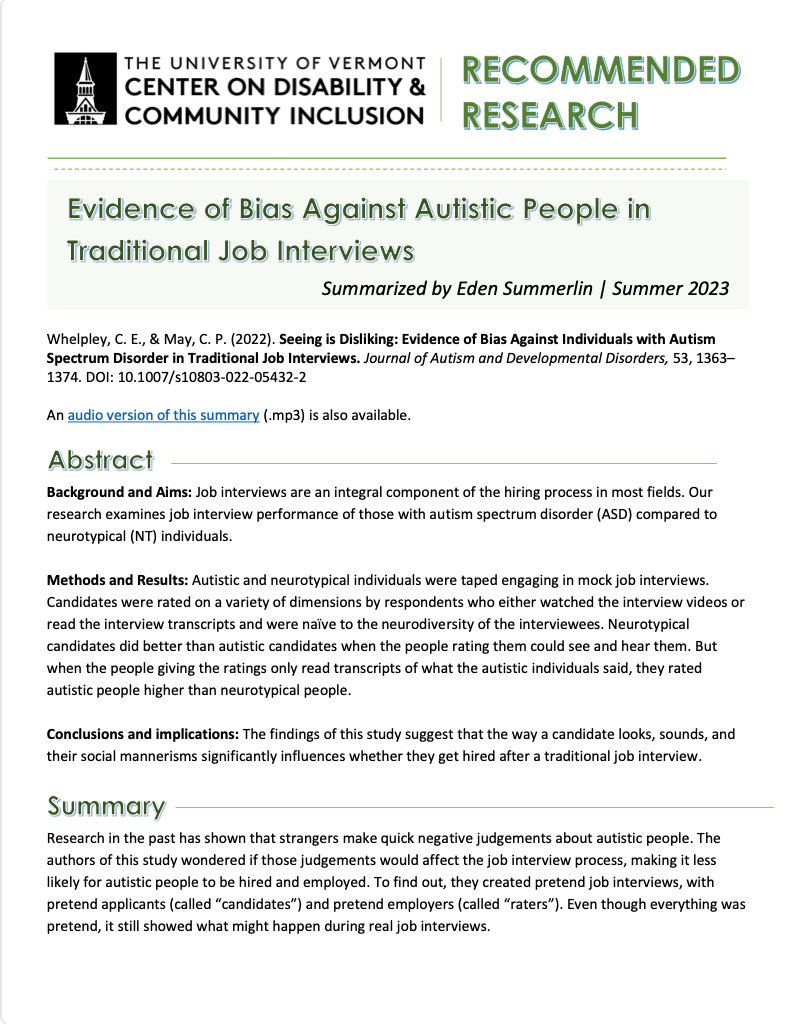What did the researchers do?
Research in the past has shown that strangers make quick negative judgements about autistic people. The authors of this study wondered if those judgements would affect the job interview process, making it less likely for autistic people to be hired and employed. To find out, they created pretend job interviews, with pretend applicants (called “candidates”) and pretend employers (called “raters”). Even though everything was pretend, it still showed what might happen during real job interviews.
30 college students volunteered for pretend job interviews. 15 of the students were autistic and 15 were neurotypical. They all gave five-minute speeches, acting like they were applying for their dream job. Their presentations were recorded on video. Afterwards, the authors of the study created transcripts of what each person said in their speech.
The authors asked other college students to be the raters. 151 raters watched video interviews, and 158 raters read transcripts of interviews. They were not told about whether the candidates were autistic. The raters were asked to rate:
- likability
- trustworthiness
- straightforwardness
- job qualifications
- attractiveness
- awkwardness
- confidence
- enthusiasm, and
- “captivation” – how captivating they found a candidate.
They were also asked if they would hire the candidate for a job.
What did the researchers learn?
In the videos of the mock job interviews, every candidate’s face, voice, and body language could be seen.
When raters watched the video interviews, they preferred neurotypical people and were more likely to “hire” them compared to autistic people. They thought of autistic people as less trustworthy, less likable, less straightforward, equally qualified, less attractive, far more awkward, less confident, less enthusiastic, and far less captivating than the neurotypical people.
In the transcripts, the only things that could be seen were the words each candidate said. When raters only read the transcripts, they preferred autistic people and were more likely to “hire” them instead of neurotypical people. Autistic people were thought of as slightly more trustworthy, slightly more likable, more straightforward, more qualified, more attractive, equally awkward, slightly more confident, more enthusiastic, and more captivating than the neurotypical people.
What does this mean for real life?
Most employers ask people to complete interviews when applying for a job. Those interviews are often in-person, and otherwise they usually happen over the phone or using a video call. In all of those circumstances, autistic people face bias against the way they look and sound. Their talents are often ignored just because of how they are perceived socially.
This has a big negative impact on autistic people’s ability to find and keep a job, even when they are very qualified for one.
Autistic people have the highest unemployment rate of any disability group, and job discrimination leading to unemployment is one reason for the high rate of homelessness and poverty among autistic people. Autistic people are not the only ones who are hurt by this. Employers are missing out on the opportunity to hire skilled workers, because their bias gets in the way of their ability to see an autistic person’s true fit for the job. In order to avoid this problem, employers need to be educated about autism.
What are the limitations of this study?
The authors said that the problem is likely worse than this study shows. In this study, people were told to pretend they were applying for their dream job. They also did not have a conversation. In a real job interview, people need to have a conversation about a job that is different from their exact dream. Autistic people probably face even more bias under those real-world circumstances, than they did in this experiment.
Also, the raters were college students, not actual employers.
The authors said that college students in this age group are probably more understanding of autism than older generations, because they have all likely had autistic classmates in school. On the other hand, college students probably have not been taught about fair hiring practices, and they probably have not had training about neurodiversity in the workplace (which some employers do have).
The authors also said that none of the autistic participants had an intellectual disability, and that other things like gender and ethnicity were not part of the analysis. It is possible that autistic people with intellectual disabilities could face even more bias than the people in this study. It is also possible that bias about gender and ethnicity could make bias even worse.
 What was this study about?
What was this study about?
